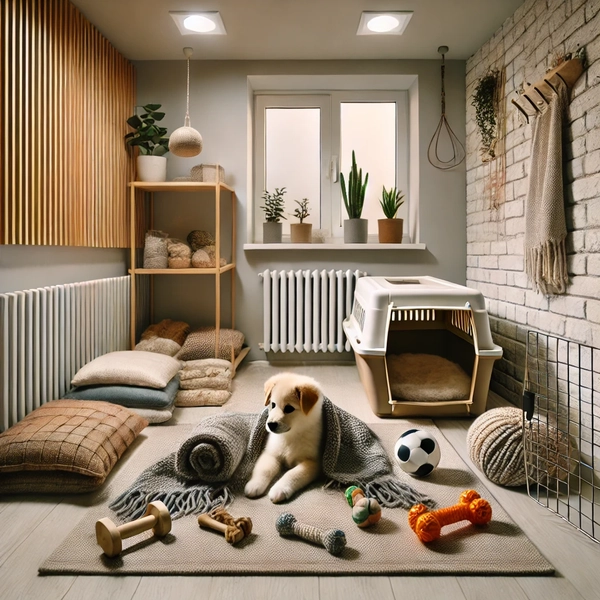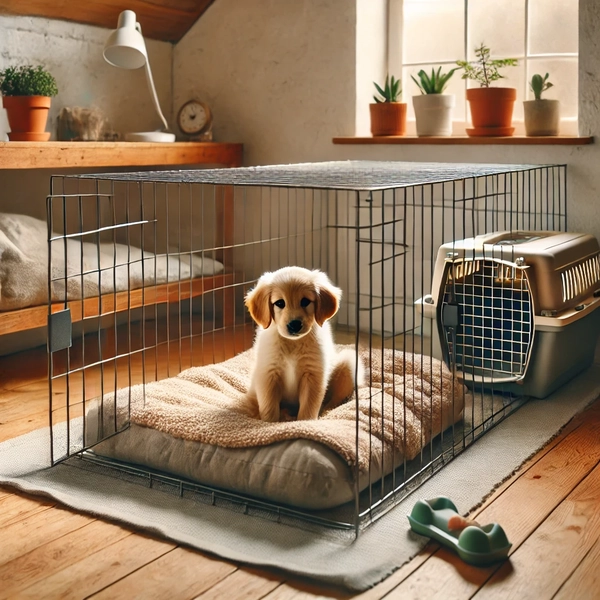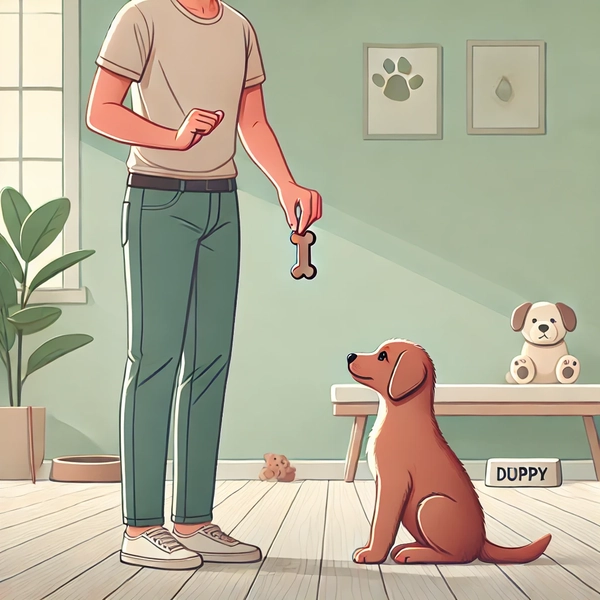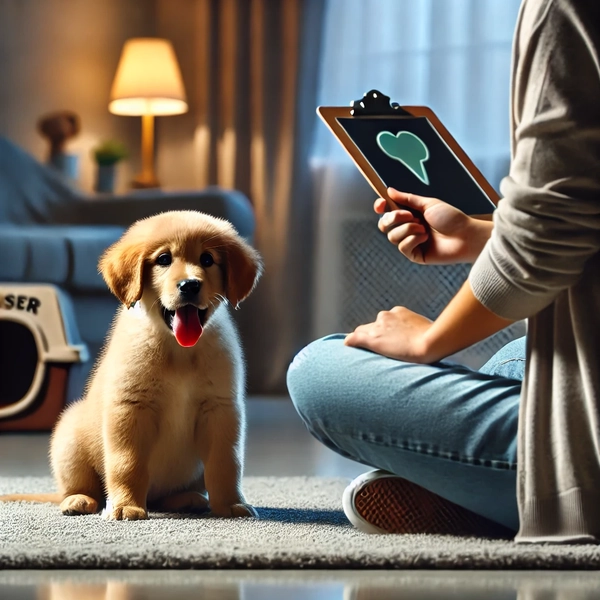How to create a safe space for a new puppy? Puppies require a friendly and secure space to acclimatize to changes or new environments and settle into their new surroundings. This article will take you every step to make your new best friend a warm and secure accommodation.
Why a Safe Space is Important

In doing so, a cozy room will also act as a normal child-proof space in the house, protecting and keeping the child from getting tiresome and unsettled.
An area within your house free from potential hazards, so they can rest and play will serve them as a home at the best times.
How to Create a Safe Space for a New Puppy

A lot depends on the preparation carried out before bringing the puppy home. It has to be comfortable and safe for the puppy and alleviate the tension of the person who will look after it.
The other part of me is still concerned and wants us to learn more about creating and organizing a safe area for a puppy. Therefore, we crave to learn more!
Step 1: Choose the Right Spot
Location is the number one determinant when deciding where the safe space for the puppy will be. One should opt for a place that will be;
- Quiet and close enough to proper civilization.
- Without sharp edges or with dangerous objects.
- It should be close enough to where the family members and pet will stay to avoid making the pet sad or lonely.
- Easy to clean since puppies have little ‘mishaps’ often.
A corner in the middle of other areas in the house or a small room would suffice. It is recommended that busy places like the kitchen or, if possible, the staircase be avoided completely, as they are risky.
Things to Avoid in the Chosen Space
| Hazard | Why It’s Dangerous |
| Cords and wires | Puppies may chew on them and get shocked |
| Sharp objects | Can cut or injure your puppy |
| Small items (like toys) | Risk of choking or swallowing |
| Cleaning supplies | Toxic if ingested |
Tip: Consider being the puppy and not the owner of the house! Is there anything on a low table they can reach, like straws or their favorite treats, particularly anything they are willing to tear up?
Step 2: Equip the Comfortable Cage
One of the best methods of providing a dog with a special space is crate training. The cage serves as a home for the puppy, where he/she can rest without worry.
What to do when it comes to selecting and fixing the cage: the cage should be mainly two things:
- Size: The cage should be large enough for the puppy to stand, turn around, and lie down.
- Bed: If you don’t have a blanket, you can also replace it with a little bed. Playing with them can sometimes distract them and let them nap. As a piece of advice, do not use a wet bed or anything with a form, as the puppy will start to destroy and eat the filling.
- Placement: Store the crate in a room of your assigned house, but leave the door open without restricting so that the puppy can use it freely and walk in and out of the crate.
Benefits of Crate Training:
- Helps with house training by teaching your pup when and where to go potty.
- Creates a place of safety during rest breaks.
- Eliminates fear of seclusion during short periods when the dog is alone.
Step 3: Puppy-Proof the Space
Much like how baby-proofing a house takes place, the safe area shall also need to be modified for the safety of the puppies. Puppies exhibit behaviors contrary to sitting still and everything still operating as it should. Their explorative natures self-warranted chewing, biting, and digging. The environment has to be devoid of any dangers to these puppies.
How to Puppy-Proof:
Cover electrical outlets and hide wires.
- Remove breakable items or anything they could knock over.
- Use baby gates or pet fences to keep your puppy within the safe area.
- Store cleaning products and other toxic items high up or in locked cabinets.
Step 4: Add Puppy-Friendly Toys
Puppies have a lot of energy and need to be kept busy. Therefore, they must be given enough toys to ensure that they are kept busy, happy, and not likely to chew anything they see.
Here are some of the best puppy-friendly toys:
- Chew toys: Perfect for teething and chewing tendencies.
- Puzzle toys: These will be effective in the preschool of the puppy, where they will be busy.
- Squeaky toys: Pets can swallow such things, and poorly constructed toys are easily ripped apart.
Toy Safety Tips
- Pick toys that are too big to swallow.
- Keep away from toys with detachable small parts, as these can be a choking hazard.
- Check the condition of the toys regularly and throw them away if they have been used a lot and are breaking apart.
Step 5: Create a Routine
Puppies find security in the regularity of events. They do well with rules, and creating a routine is expected to help them acclimate to migration.
Here’s a sample routine you can follow:
| Time | Activity |
| 7:00 AM | Morning walk/potty break |
| 8:00 AM | Breakfast and playtime |
| 10:00 AM | Nap in the crate |
| 12:00 PM | Lunch and outdoor play |
| 2:00 PM | Afternoon nap |
| 4:00 PM | Training or interactive play |
| 6:00 PM | Dinner |
| 8:00 PM | Calm time and snuggles |
| 9:00 PM | Bedtime in the crate |
Why Routine Matters
- Consistency in meals, play, and nap times clarifies what is expected of your puppy.
- Enhances good behavior by organizing their day for them and providing some form of business.
- And eases anxiety in new places.
Step 6: Positive Reinforcement Training

One significant advantage of training your puppy is the feeling of reassurance that it gives you and your puppy as well. On a positive note, positive reinforcement, which is beneficial to the individual and the animal, teaches you how to train and develop your puppy.
Guide of Training with Positive Reinforcement:
- Teach them that when they go outside, they get a treat if they use the bathroom or come over and sit on command as they will receive one.
- Speak to them nicely and praise them as required.
- Avoid prolonging training sessions for more than 15-20 minutes once or twice a day for a week; the puppy’s age does not matter.
This method makes the growing relationship more comfortable and, importantly, helps the puppy learn and save itself from consequences without fear.
Step 7: Introduce Your Puppy Slowly
Never rush! Your puppy needs time to acclimate to the new place. Let them unruffle the house step by step. Begin with the safe trainer, then add other areas of the house one by one.
Recommendations on the Introduction of a Puppy to New Spaces:
- Take care to walk the puppy into new rooms; otherwise, keep the puppy with someone who stays there.
- Close off the rooms that you do not wish your puppy to enter.
- Let the puppy counter itself slowly in unknown territories without imposing your idea.
Step 8: Monitor for Signs of Stress

The cost of stress in puppies is too high today; hence, they are very fast at adapting to new spaces. Do make sure that they are not in a state of conception in their language, and constantly watch them in the event that they are quiet.
Relevant to signs of stress in puppies are the following:
- Observed increased respiration and salivation that is not associated with heat
- Persistent barking or circling the same area
- He is either escaping the situation or hiding somewhere
If these well-known symptoms persist, be sure to use the following calming techniques on your puppy:
Offer a Mellowed Spot for Them to Find Rest
- Calm aggression or fear towards them by wearing more calming tones
- Prepare a series of exercises with one favorite chewing toy at a time, or use a chew to make them a bit quiet.
Step 9: Ensure Proper Socialization
No matter how safe you may provide the physical space of this one, it is important to expose it to the world. The process of this exposure is called socialization.
The activities that you should undertake and the ones that involve the surrounding issues are as follows:
- Encourage your friends and family to come over and meet the new hotting in the place.
- They must be as fair and accessible as possible in introducing the new pet to the already present dogs, such as a quiet, friendly dog.
- Help them express themselves when playing outside or in a nearby, quiet park or playground to familiarize themselves with different activities from the environment and the people.
- Socialization must always be conducted in a manner that is enjoyable rather than detrimental to the puppy involved. Puppies do not like to be scared, and it’s therefore extremely wrong and regretful to endanger their best interest.
Step 10: Be Patient and Loving
Of course, one does not have to be reminded that it is not very easy when one is a student, but slow pacing is critical. Puppies tend to make various mistakes due to their lack of skills.
What Proper Dares to Take during the Fallacies:
- Breathe and speak calmly. Young dogs can interpret feelings right away.
- Reward the behavior with some soft guidance if necessary; however, do not allow correction through negative means.
- Make sure they are encouraged and praised whenever they do good.
- Eventually, with your help and affection, a puppy can cope with life and be cheerful and self-confident.
In conclusion, If you are considering living with your spouse for a long time with a healthy dog, know that the first phase is creating a safe place for your puppy.
Providing your puppy with a secure and calm environment, routine, and lots of positive reinforcement is the first step to instilling good behavior and trust in them.
Your safe space goes beyond being a room or area used by your puppy—it provides them with a safe environment that supports and nurtures them within the newly adopted home. Given those two elements and with a bit of effort, people are likely to ensure that their dogs turn into admirable pets!